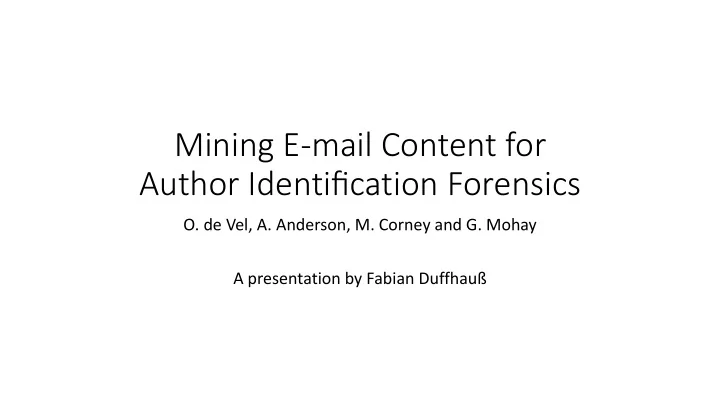

Mining E-mail Content for Author Identification Forensics O. de Vel, A. Anderson, M. Corney and G. Mohay A presentation by Fabian Duffhauß
Reasons for Author Identification of E-mails • Everyday 200 billions of e-mails are sent → 90 % spam • Misuse of e-mails: • Distribute inappropriate messages or documents • Send offensive or threatening material • sender try to hide their identity → identify the author of e-mail misuse 2
E-mail Topic and Authors Used in the Experiments Topic Author Category AC i (i = 1; 2; 3) Topic Category Total Author AC 1 Author AC 2 Author AC 3 Movie 15 21 21 59 Food 12 21 25 58 Travel 3 21 15 39 Author Total 30 63 63 156 • salutations, reply text, attachments and signatures are removed • Existence and position are stored 3
170 Style Marker Attribute Types • Number of blank lines/total number of lines • Average sentence length M = total number of words • Average word length (number of characters) V = total number of distinct words • Vocabulary richness i.e., V/M • Total number of function words/M C = total number of characters • Function word frequency distribution (122 features) • Total number of short words/M • Count of hapax legomena/M • Count of hapax legomena/V • Total number of characters in words/C • Total number of alphabetic characters in words/C • Total number of upper-case characters in words/C • Total number of digit characters in words/C • Total number of white-space characters/C • Total number of space characters/C • Total number of space characters/number white-space characters • Total number of tab spaces/C • Total number of tab spaces/number white-space characters • Total number of punctuations/C • Word length frequency distribution/M (30 features) 4
21 Structural Attribute Types • Has a greeting acknowledgment • Uses a farewell acknowledgment • Contains signature text • Number of attachments • Position of requoted text within e-mail body • HTML tag frequency distribution/total number of HTML tags (16 features) 5
Support Vector Machine Classifier • SVM light • separate objects into two different classes. • Best results with a polynomial kernel of degree 3 6
Measuring Units • C = set of objects that belong to a class • A = set of objects the classifier has identified as belonging to the class 𝐷 ∩ 𝐵 𝐷 ∩ 𝐵 𝑠𝑓𝑑𝑏𝑚𝑚 𝑆 = 𝑞𝑠𝑓𝑑𝑗𝑡𝑗𝑝𝑜 𝑄 = 𝐷 𝐵 𝐺 = 2𝑆𝑄 𝑆 + 𝑄 7
First Experiment style markers and structural features • Mixed topics Performance Author Category, AC i (i = 1, 2, 3) • Stratified 10-fold cross Statistic Author AC 1 Author AC 2 Author AC 3 validation procedure P ACi 100.0 % 83.8 % 93.8 % R ACi 63.3 % 98.3 % 89.6 % F ACi 77.6 % 90.5 % 91.6 % only style markers Performance Author Category, AC i (i = 1, 2, 3) Statistic Author AC 1 Author AC 2 Author AC 3 P ACi 100.0 % 93.0 % 83.6 % R ACi 60.0 % 80.3 % 93.3 % F AC i 75.0 % 86.2 % 88.2 % 8
Second Experiment • Training set: E- mails with topic “Movie” style markers and structural features Author Category, AC i ( i = 1, 2, 3) Author AC 1 Author AC 2 Author AC 3 Topic Class P AC1 R AC1 F AC1 P AC2 R AC2 F AC2 P AC3 R AC3 F AC3 Food 100.0 16.7 28.6 77.8 100.0 87.5 85.2 92.0 88.5 Travel 100.0 33.3 50.0 90.9 100.0 95.2 100.0 100.0 100.0 categorisation performance results (in %) 9
Third Experiment • Number of function words: 320 (instead of 122) • Split into parts-of-speech words and others • Result: No improvements 10
PAN-11 Author Identification Training Corpus training sets Validation sets Name Number of Number of Name Number Number of Authors Documents of Authors Documents Large 72 9337 LargeValid 66 1298 Small 26 3001 LargeValid+ 86 1440 Verify1 1 42 SmallValid 23 518 Verify2 1 55 SmallValid+ 43 601 Verify3 1 47 Verify1Valid+ 24 104 Verify2Valid+ 21 95 Verify3Valid+ 23 100 11
Live Demonstration • Parser in C++: • Reads a list of function words • Reads the e-mail bodies • Extracts style marker attributes • Creates training and test files • SVM light -Learn: • Reads the training file • Creates a model • SVM light -Classify: • Reads the model and the test file • Makes a prediction 12
Recommend
More recommend